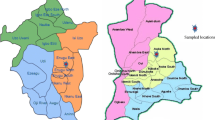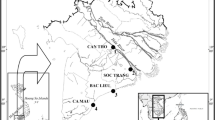Abstract
The freshwater snakehead fishes are members of the family Channidae and order Perciform, which are native to parts of Africa and Asia with widespread distributions. The present study was aimed to assess the genetic variability and molecular phylogeny among 22 species of genus Channa, viz. C. argus, C. asiatica, C. aurantimaculata, C. bankanensis, C. barca, C. bleheri, C. burmanica, C. diplogramma, C. gachua, C. lucius, C. maculata, C. marulius, C. melasoma, C. micropeltis, C. orientalis, C. ornatipinnis, C. panaw, C. pleurophthlama, C. pulchra, C. punctata, C. stewartii and C. striata, using partial 513 bp long consensus sequence of cytochrome-c oxidase subunit I mitochondrial DNA retrieved from NCBI (March, 2018). The study showed 281 haplotypes with 267 variable sites (i.e., 33 singletons and 234 parsimoniously informative) in nucleotide positions. Most of the sequences were A + T rich, except in C. argus which is G + C rich (50.25%). The NJ and MP trees showed similar topology with discrete branches, each as a distinct species of the Channa with slight differences in bootstrap values. Maximum K2P distance was found between the C. ornatipinnis and the C. melasoma. The maximum numbers of polymorphic loci were present in C. gachua.



Similar content being viewed by others
References
Fowler HW (1934) Descriptions of new fishes obtained 1907 to 1910, chiefly in the Philippine islands and adjacent seas. Proc Acad Nat Sci Phila 85:233–367
Baisvar VS, Kumar R, Singh M, Singh AK, Chauhan UK, Mishra AK, Kushwaha B (2018) Genetic diversity analyses for population structuring in Channa striata using mitochondrial and microsatellite DNA regions with implication to their conservation in Indian waters. Meta Gene 16:28–38
Hossain MK, Latifa GA, Rahman MM (2008) Observations on induced breeding of snakehead murrel, Channa striatus (Bloch, 1793). Int J Sustain Crop Prod 3:65–68
Brown WM, George JM, Wilson AC (1979) Rapid evolution of animal mitochondrial DNA. Proc Natl Acad Sci USA 76:1967–1971
Singh M, Lakra WS, Bahuguna SN, Kartavtsev YPH (2012) Cytochrome b gene sequence divergence of seven sisorid species of catfish genus Glyptothorax (Siluriformes, Sisoridae) from India. Mol Biol Rep 39:4275–4282
Ward RD, Zemlak TS, Innes BH, Last PR, Hebert PDN (2005) DNA barcoding Australia’s fish species. Philos Trans R Soc B Biol Sci 360:1847–1857
Hubert N, Hanner R, Holm E, Mandrak NE, Taylor E, Burridge M et al (2008) Identifying Canadian freshwater fishes through DNA barcodes. PLoS ONE 3:e2490
Meyer SC, Ross M, Nelson P, Chin P (2003) The Cambrian explosion: biology’s big bang. In: Campbell JA, Meyer SC (eds) Darwinism, design and public education. Michigan State University Press, Lansing, pp 323–402
Adamson EAS, Hurwood DA, Mather PA (2010) A reappraisal of the evolution of Asian snakehead fishes (Pisces, Channidae) using molecular data from multiple genes and fossil calibration. Mol Phylogenet Evol 56:707–717
Lakra WS, Goswami M, Gopalakrishnan A, Singh DP, Singh A, Nagpure NS (2010) Genetic relatedness among fish species of Genus Channa using mitochondrial DNA genes. Biochem Syst Ecol 38:1212–1219
Serrao NR, Steinke D, Hanner RH (2014) Calibrating snakehead diversity with DNA barcodes: expanding taxonomic coverage to enable identification of potential and established invasive species. PLoS ONE 10:9
Conte-Grand C, Britz R, Dahanukar N, Raghavan R, Pethiyagod R, Tan HH, Hadiaty RK, Yaakob NS, Rüber L (2017) Barcoding snakeheads (Teleostei, Channidae) revisited: discovering greater species diversity and resolving perpetuated taxonomic confusions. PLoS ONE 12:e0184017
Talwar PK, Jhingran AG (1992) Inland fishes of India and adjacent countries, vol 1. Balkema Publishers, Rotterdam, p 1158
Sambrook J, Fritsch EF, Maniatis T (1989) Molecular cloning: a laboratory manual, 2nd edn. Cold Spring Harbor Laboratory Press, New York
Sanger F, Nicklen S, Coulson AR (1977) DNA sequencing with chain-terminating inhibitors. Proc Natl Acad Sci USA 74:5463–5467
Tamura K, Peterson D, Peterson N, Stecher G, Nei M, Kumar S (2011) MEGA5: molecular evolutionary genetics analysis using maximum likelihood, evolutionary distance and maximum parsimony methods. Mol Biol Evol 28:2731–2739
Kimura MA (1980) Simple method for estimating rate of base substitutions through comparative studies of nucleotide sequences. J Mol Evol 16:111–120
Excoffier L, Lischer HEL (2010) Arlequin Suite Ver 3.5: a new series of programs to perform population genetics analyses under Linux and Windows. Mol Ecol Res 10:564–567
Rozas J (2009) DNA sequence polymorphism analysis using DnaSP: pp 337–350. In Posada D (ed) Bioinformatics for DNA sequence analysis. Methods Mol Biol Series 537. Humana Press NJ, USA
Darriba D, Taboada GL, Doallo R, Posada D (2012) J Model Test 2: more models, new heuristics and parallel computing. Nat Methods 9:772
Felsenstein J (1985) Confidence limits on phylogenies: an approach using the bootstrap. J Evol 39:783–791
Perrier X, Jacquemoud-Collet JP (2006) DARwin software. http://darwin.cirad.fr/. Accessed on 10 July 2016
Drummond AJ, Suchard MA, Xie D, Rambaut A (2012) Bayesian phylogenetics with BEAUti and the BEAST 1.7. Mol Biol Evol 29:1969–1973
Stamatakis A (2014) RAxML version 8: a tool for phylogenetic analysis and post-analysis of large phylogenies. J Bioinform 30:1312–1313
Sharp PM, Tuohy TMF, Mosurski KR (1986) Codon usage in yeast: cluster analysis clearly differentiates between highly and lowly expressed genes. Nucleic Acids Res 14:125–5143
Bofkin L, Goldman N (2007) Variation in evolutionary processes at different codon positions. Mol Biol Evol 24:513–521
Dudu A, Georgescu SE, Popa O, Dinischiotu A, Costache M (2011) Mitochondrial 16S and 12S rRNA sequence analysis in four salmonid species from Romania. Acta Zool Acad Scient Hung 57:233–246
Sauna ZE, Kimchi-Sarfaty C (2011) Understanding the contribution of synonymous mutations to human disease. Nat Rev Genet 12:683–691
Naya H, Romero H, Carels N, Zavala A, Musto H (2001) Translational selection shapes codon usage in the GC-rich genomes of Chlamydomonas reinhardtii. FEBS Lett 501:127–130
Yang F, Ding F, Chen H, He M, Zhu S, Ma X, Jiang L, Li H (2018) DNA barcoding for the identification and authentication of animal species in traditional medicine. Evid-Based Complement Altern Med 2018:1–18
Acknowledgements
The authors gratefully thank to ICAR-National Bureau of Fish Genetic Resources, Lucknow for providing the financial support and encouragement. The financial support for tissue sampling and DNA sequencing of fishes was taken under the institutional projects entitled ‘Genetic stock structure elucidation of Tenualosa ilisha and Channa striata using microsatellite, mitochondrial DNA and molecular cytogenetic markers’ and ‘DNA barcoding of India fishes,’ which is duly acknowledged.
Author information
Authors and Affiliations
Corresponding author
Ethics declarations
Conflict of interest
The authors declare that there is no conflict of interest to publish this manuscript.
Additional information
Significance Statement
Genetic variability among 22 Channa spp. was assessed using COI gene. Study showed 281 haplotypes with 267 variable sites. C. gachua had maximum polymorphic loci. Maximum genetic distance using K2P was found between C. ornatipinnis and C. melasoma.
Electronic Supplementary Material
Below is the link to the electronic supplementary material.
Rights and permissions
About this article
Cite this article
Baisvar, V.S., Kumar, R., Singh, M. et al. Cytochrome-C Oxidase I Gene-Based Genetic Divergence and Molecular Phylogeny Among the Species of Fish Genus Channa. Proc. Natl. Acad. Sci., India, Sect. B Biol. Sci. 89, 1455–1463 (2019). https://doi.org/10.1007/s40011-018-01070-w
Received:
Revised:
Accepted:
Published:
Issue Date:
DOI: https://doi.org/10.1007/s40011-018-01070-w




